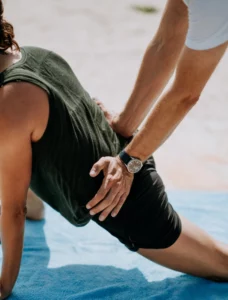Iliopsoas bursitis, a condition affecting the hip joint, can be a source of discomfort and limited mobility for many individuals. In this article, we will delve into what exactly iliopsoas bursitis is, its causes, symptoms, and various treatment options. We will also explore some self-care measures, and prevention strategies, and discuss when it’s essential to seek medical attention.
Contents
Understanding Iliopsoas Bursitis

Iliopsoas bursitis, also known as iliopsoas tendonitis or hip bursitis, is a medical condition characterized by inflammation of the bursa located in the hip region. Bursae are small, fluid-filled sacs that act as cushions between tendons, muscles, and bones, reducing friction and allowing smooth movement.
The iliopsoas is a combination of two muscles in the hip area: the iliacus and the psoas major. These muscles play a crucial role in hip flexion, which is the movement of bringing the thigh toward the abdomen. The iliopsoas bursa is situated between these muscles and the underlying hip joint, facilitating their smooth movement.
When the bursa becomes inflamed due to overuse, repetitive motions, trauma, or other underlying conditions, it can lead to iliopsoas bursitis. The inflammation can cause pain and discomfort in the front of the hip or groin area. Additionally, the pain might radiate down the front of the thigh.
Causes and Risk Factors
Iliopsoas bursitis can be caused by various factors related to the hip joint and surrounding structures. Some common causes and risk factors include:
- Overuse or Repetitive Movements: Activities that involve repeated hip flexion and extension, such as running, cycling, or certain sports, can put a strain on the iliopsoas muscle and the bursa, leading to inflammation.
- Trauma or Injury: Direct trauma to the hip area, such as a fall or impact, can cause irritation and inflammation of the iliopsoas bursa.
- Hip Joint Problems: Underlying hip joint conditions like hip osteoarthritis or femoroacetabular impingement (FAI) can contribute to bursitis by causing abnormal hip mechanics and increased stress on the bursa.
- Muscle Imbalances: Imbalances in the strength or flexibility of the muscles around the hip joint, including the iliopsoas, can lead to abnormal mechanics and contribute to bursitis.
- Inflammatory Conditions: Certain systemic inflammatory conditions, such as rheumatoid arthritis or ankylosing spondylitis, can increase the risk of developing bursitis.
- Hip Surgery: Previous hip surgery can disrupt the normal anatomy and biomechanics of the hip, potentially leading to bursitis.
Signs and Symptoms
The signs and symptoms of iliopsoas bursitis can vary from person to person, but they typically involve pain and discomfort in the hip or groin region. Here are the common signs and symptoms associated with iliopsoas bursitis:
- Hip or Groin Pain: The primary symptom is pain located in the front of the hip or the groin area. The pain can be sharp, achy, or throbbing and may worsen with movement.
- Pain with Hip Movement: Activities that involve hip flexion (bending the hip joint) or extension (moving the hip joint backward) can exacerbate the pain. For example, climbing stairs, lifting the leg, or sitting for prolonged periods may trigger discomfort.
- Radiating Pain: The pain from iliopsoas bursitis may sometimes radiate down the front of the thigh towards the knee.
- Painful Lying Down: Some individuals may experience increased pain when lying down on the affected side or when trying to bring the knee towards the chest.
- Stiffness: The hip may feel stiff or limited in its range of motion due to inflammation and discomfort.
- Tenderness and Swelling: The hip region might be tender to the touch, and there may be localized swelling over the bursa.
- Difficulty Walking: In severe cases, the pain and stiffness can lead to difficulty in walking normally.
Treatments of Iliopsoas Bursitis
The treatment of iliopsoas bursitis typically begins with conservative, non-invasive measures. Some of these ways are:
Invasive Treatments
Invasive treatments for iliopsoas bursitis are typically considered when conservative measures, such as rest, physical therapy, and medications, have not provided sufficient relief.
Here are some common invasive treatments for iliopsoas bursitis:
- Corticosteroid Injections: Corticosteroid injections are a common approach to manage inflammation and provide pain relief. A corticosteroid medication is injected directly into the inflamed bursa to reduce swelling and alleviate discomfort. This treatment can offer temporary relief, but it may not be a long-term solution.
- Aspiration: In some cases, a healthcare provider may use a needle and syringe to aspirate or withdraw excess fluid from the inflamed bursa. This can help reduce pressure and relieve symptoms.
- Ultrasound-guided Injections: To ensure accurate placement of the corticosteroid or other medications, the healthcare provider may use ultrasound guidance during the injection process. This helps target the affected area more precisely and can improve treatment outcomes.
- Platelet-Rich Plasma (PRP) Injections: PRP therapy involves injecting a concentration of the patient’s platelets into the inflamed bursa. Platelets contain growth factors that may aid in tissue healing and reduce inflammation.
Home Remedies and Self-Care

These are some of the home remedies and self-care:
Rest and Protecting the Hip Joint
One of the simplest yet effective self-care measures is giving the hip joint adequate rest, and avoiding strenuous activities that may worsen the inflammation.
Applying Ice and Heat
Applying ice packs in the initial stages of pain can reduce swelling, while applying heat packs, later on, can help soothe muscle tension.
Gentle Stretching Exercises
Engaging in gentle stretching exercises, under the guidance of a physical therapist, can improve flexibility and reduce muscle stiffness.
Over-the-Counter Pain Relief
Over-the-counter pain relievers like acetaminophen or NSAIDs can be used as directed to manage pain and inflammation.
Using Proper Body Mechanics
Practicing good body mechanics during daily activities can minimize stress on the hip joint and reduce the risk of bursitis recurrence.
Prevention and Lifestyle Changes
Prevention and lifestyle changes can play a significant role in reducing the risk of developing iliopsoas bursitis and managing the condition if you have experienced it before. Here are some preventive measures and lifestyle changes that can be beneficial:
- Hip Strengthening Exercises: Engaging in regular hip-strengthening exercises can help improve the stability of the hip joint and reduce the risk of bursitis. Focus on exercises that target the hip abductors, adductors, and flexors. Consult a physical therapist or fitness professional to design a suitable exercise program.
- Flexibility and Stretching: Maintain good hip flexibility by incorporating stretching exercises into your routine. Stretching can help reduce muscle imbalances and improve hip range of motion.
- Proper Warm-Up and Cool-Down: Always warm up before engaging in physical activities or exercises and cool down afterward. Gradually increase the intensity of your workouts to avoid sudden stress on the hip joint.
- Proper Body Mechanics: Pay attention to your posture and body mechanics during daily activities and exercise. Avoid sudden movements or overloading the hip joint.
Indications for Seeking Medical Attention

While mild cases of iliopsoas bursitis can often be managed with self-care and conservative measures, certain indications warrant seeking medical attention promptly. If you experience any of the following symptoms or situations, it is advisable to consult a healthcare professional:
- Severe Pain: If you are experiencing intense or debilitating pain in the hip or groin area that is not responding to over-the-counter pain medications or rest, it’s crucial to seek medical evaluation.
- Swelling or Redness: If you notice significant swelling or redness around the hip joint, it could indicate inflammation or infection, which requires medical attention.
- Fever: If you develop a fever along with hip pain or other symptoms, it may suggest an infection and immediate medical attention is necessary.
- Inability to Bear Weight: If you find it difficult or impossible to bear weight on the affected hip or leg, it could indicate a more severe injury or underlying issue that requires evaluation.
- Pain that Persists or Worsens: If your hip pain persists for several days or weeks, or if it becomes progressively worse, it’s essential to get it assessed by a healthcare professional to determine the underlying cause.
Recovery Expectations
After recovering from iliopsoas bursitis, it’s essential to take certain precautions and adopt lifestyle habits to maintain hip health and reduce the risk of bursitis recurrence. Here are some after-recovery tips:
- Gradual Return to Activities: When resuming physical activities and exercise, start gradually and progressively increase the intensity. This approach allows your hip joint and muscles to adapt and reduces the risk of overuse injuries.
- Continue Hip-Strengthening Exercises: Maintain a regular exercise routine that includes hip-strengthening exercises to keep the hip muscles strong and stable. Incorporate exercises that target the hip abductors, adductors, and flexors.
- Focus on Flexibility: Continue to work on hip flexibility through regular stretching exercises. Flexibility helps improve joint mobility and reduces the risk of muscle imbalances.
- Proper Warm-up and Cool-Down: Always warm up before engaging in physical activities and cool down afterward. This helps prepare the muscles and joints for activity and aids in preventing injuries.
Conclusion
Iliopsoas bursitis can be a painful condition, but with the right treatment and self-care measures, individuals can experience significant relief and recovery. Understanding the causes, symptoms, and treatment options allows individuals to take proactive steps in managing this condition and prevent its recurrence.
If you’re experiencing Hip pain, physical therapy for hip pain at PhysioMantra can help: Book an online physical therapy session.



